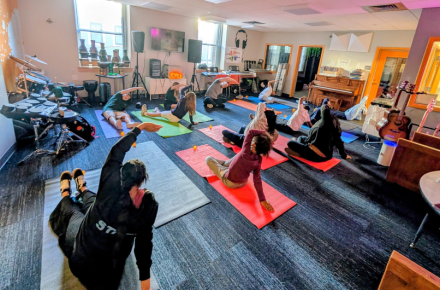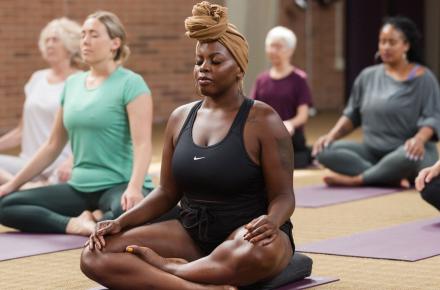How to Make a Singing Bowl Sing


I used to attend classes at Yoga to the People (YTTP), a “pay what you wish” studio in New York City, where I could breathe and sweat with 100 strangers, a thumb-width between our mats. The class concluded with the rubbing of a frosted crystal singing bowl, big enough to serve salad for 50. It seemed like a relic from The Dark Crystal. When it sang, I sometimes saw colors twirl and fade, a virtual tie-dye behind my lids.
The bowl kept me coming back. My busy brain felt cleaned out afterward, like I’d used a kind of mind floss. We were supposed to keep our eyes shut until the end, but I peeked as our teacher scooped the wand around the lip, stirring up a mighty hum. I wanted to know how it worked.
The singing bowl, I discovered, is an ancestor of the bronze standing bell, or inverted bell, which is struck with a mallet to chime one note. Standing bells originated in China during the Shang dynasty (16th–11th centuries BC) and are still used to accompany meditation. An early form called “nao” looked like a metal goblet. These were cast with molten metal and hand-hammered into a certain shape and size. Tibetan singing bowls, also made from metal, first appeared around 560–480 BC.
Frosted crystal bowls, by contrast, are a modern phenomenon, made from crushed quartz and heated to 4000 degrees in a centrifuge. Clear quartz singing bowls are glass blown with pressurized air in a high-temperature mold. The clear bowls take on a range of colors when gemstones are added to the quartz.
"Anyone can learn to play the bowls,” says Kripalu presenter Ashana, renowned performer, teacher, and sound healer. They’re simple and accessible instruments, and the concepts of playing are easily learned. The key is learning to play the bowls well. Having a mentor can impact the power of your playing.”
The “singing” is a result of the stick-slip mechanism, the same principle used to play water-tuned musical glasses. As I witnessed at YTTP, the speed and force of the mallet around the rim determine the volume of the continuous note. The larger bowls carry more reverberation, causing the tone to linger, apt for all those prone bodies listening in Savasana. Bowls usually sound one of seven notes (C, D, E, F, G, A, or B) which correspond, in sound therapy, to the seven chakras.
“The selection of bowls depends upon which chakra in the body we’re focusing on,” says Monte Hansen, who presents sound baths with singing bowls in the Washington DC area. “For example, if someone wants to have a grounding meditation, we use bowls that primarily resonate the C note because it affects the lower chakra. If they are looking for a heart-opening session, we select bowls that resonate the F note.”
The “clean brain” feeling I experienced after hearing the bowl is called entrainment, brainwave stimulation via pulsing sound or light. The tone of the singing bowl pulses slightly, encouraging brainwaves to follow a given pattern.
“Your brain is like a human computer,” says Monte. “You have all these tabs open and, over time, your system will remind you that it’s time to reboot. When you finally allow your system to recalibrate, what happens? It comes back faster, fresher, and clearer.”
Says author Jevon Dangeli, the sound frequencies created by singing bowls can also restore the flow of energy along the body’s meridians, as in Chinese Traditional Medicine. Science recognizes the effects as well: In a 2016 study published in The Journal of Evidence-Based Integrative Medicine participants reported less tension, anger, fatigue, and depression after sound meditation.
“Every culture on earth has used sound and music in their healing rituals for thousands of years,” wrote the late Mitchell Gaynor, who served as director of Medical Oncology and Integrative Medicine at the Cornell Cancer Prevention Center. “But if somebody had told me, when I was a medical student, that one day I’d be teaching my patients to use singing bowls to heal themselves, I’d have thought he or she was crazy.” Dr. Gaynor believed that “sound can redress imbalances and can play a positive role in the treatment of virtually any medical disorder.”
For Ashana, “The sound of the bowls is the sound of our higher nature calling us back. It speaks to the longing we have. Crystal bowls are like, ‘E.T. phone home.’ It’s the fastest way I know to move into a meditative state of heightened awareness. It’s a delicious, relaxing, nurturing, and comforting experience."
I wondered how to begin. Ashana started playing 20 years ago because her mentor thought it would be beneficial. “I ordered one right then and there, sight unseen, a 14-inch classic frosted G for the throat chakra. It arrived three weeks later, double boxed and floating in a sea of white peanuts. I took it into my kitchen, carefully pulled it out of the box, and set it on the table. I chimed the side of the bowl with the mallet and promptly burst into tears and sobbed for five minutes straight. It was the most beautiful sound I had ever heard. Once I stopped crying, my first thought was that light had come to live in my house. And almost immediately after that thought, I knew that one day I would put the bowls into music. Three weeks later, I had seven bowls. Six years later, I recorded my first album. And now I have 100 bowls. They have their own room in my house.”
I started small, with a metal meditation bowl hand-cast in Nepal. It came in a bright blue box (the color of the throat chakra, center of communication) with a wooden mallet the size of my pinky. I tried it out on my birthday and decided it will become part of my writing ritual, a way to clear self-doubt before I begin. And to clear any negative emotions I might be feeling about being one year older. It’s a soothing chime in G. (I now have my eye on a classic frosted.)
“We’re at a crucial time in our human evolution,” Ashana says. “For those who feel a calling to work with this vibrational sound, listen! We need your voice and your loving intention now. And if I can help you, it will be my joy to be a guide along your way.”
I’ll soon need a bowl room of my own.
Find out more about Ashana’s Vibrational Ecstasy program at Kripalu.
Lara Tupper sings, writes, and teaches in the Berkshires. laratupper.com
© Kripalu Center for Yoga & Health. All rights reserved. To request permission to reprint, please email editor@kripalu.org.



















































